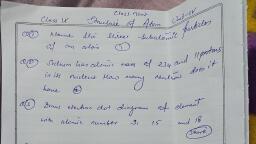Question 2 :
Which of the following statements about Rutherford’s model of atom are correct?
(i) considered the nucleus as positively charged
(ii) established that the $\alpha$–particles are four times as heavy as a hydrogen atom
(iii) can be compared to solar system
(iv) was in agreement with Thomson’s model
Question 3 :
The ratio of the radii of hydrogen atom and its nucleus is ~ $10^{5}$. Assuming the atom and the nucleus to be spherical and if atom is represented by planet earth $‘R’=6.4\times 10^{8}m$ , estimate the size of the nucleus.
Question 5 :
Rutherford’s 'alpha ($\alpha$) particles scattering experiment’ resulted in to discovery of _______.
Question 6 :
Which of the following element has an atom with one electron, one proton and no neutron ?
Question 7 :
The number of electrons in an element X is 15 and the number of neutrons is 16. Which of the following is the correct representation of the element?
Question 8 :
Rutherford’s $\alpha$–particle scattering experiment showed that
(i) electrons have negative charge
(ii) the mass and positive charge of the atom is concentrated in the nucleus
(iii) neutron exists in the nucleus
(iv) most of the space in atom is empty
Which of the above statements are correct?
Question 9 :
Which of the following scientist identified the 'Electrons' in the structure of an atom ?
Question 10 :
In the Thomson’s model of atom, which of the following statments are correct?
(i) the mass of the atom is assumed to be uniformaly distributed over the atom
(ii) the positive charge is assumed to be uniformaly distributed over the atom
(iii) the electrons are uniformaly distributed in the positively charged sphere
(iv) the electrons attract each other to stabilise the atom.
Question 11 :
One electron is present in the outer most shell of the atom of an element X. What would be the value of charge on the ion formed if this electron is removed from the outermost shell ?
Question 12 :
Which of the following scientist identified the 'Atomic number' in the structure of an atom ?
Question 13 :
Calculate the number of neutrons present in the nucleus of an element X which is represented as $_{15}^{31}X$.
Question 14 :
In the Thomson’s model of atom, which of the following statments are correct?
(i) the mass of the atom is assumed to be uniformaly distributed over the atom
(ii) the positive charge is assumed to be uniformaly distributed over the atom
(iii) the electrons are uniformaly distributed in the positively charged sphere
(iv) the electrons attract each other to stabilise the atom.
Question 15 :
How many electrons are there in the L shell of chlorine atom ?
Question 16 :
Which of the following scientist identified the 'Stationary orbits' in the structure of an atom ?
Question 17 :
State true or false: In an atom the number of protons and electrons is always equal.
Question 18 :
Rutherford’s α-particle scattering experiment led to the discovery of the ____________.
Question 19 :
In the Gold foil experiment of Geiger and Marsden, that paved the way for Rutherford’s model of an atom, ~ 1.00% of the $\alpha$-particles were found to deflect at angles > $50^{\circ}$. If one mole of $\alpha$-particles were bombarded on the gold foil, compute the number of $\alpha$-particles that would deflect at angles less than $50^{\circ}$.
Question 20 :
Which of the following correctly represent the electronic distribution in the Mg atom?
Question 21 :
Is it possible for the atom of an element to have one electron, one proton and no neutron. (Yes/No)
Question 23 :
Which of the following scientist identified the 'Atomic number' in the structure of an atom ?
Question 24 :
Helium atom has a valency of zero, even after having 2 electrons in its valence shell, because
Question 25 :
Which of the following scientist identified the 'Neutron' in the structure of an atom ?
Question 26 :
Which of the following is the correct electron distribution of chlorine atom ? (Atomic number of chlorine is 17).
Question 27 :
The atomic number of calcium and argon are 20 and 18 respectively, but the mass number of both these elements is 40. What is the name given to such a pair of elements?
Question 28 :
In the atom of an element X, 6 electrons are present in the outermost shell. If it acquires noble gas configuration by accepting requisite number of electrons, then what would be the charge on the ion so formed?
Question 29 :
Which of the following statements about Rutherford’s model of atom are correct?
(i) considered the nucleus as positively charged
(ii) established that the $\alpha$–particles are four times as heavy as a hydrogen atom
(iii) can be compared to solar system
(iv) was in agreement with Thomson’s model
Question 30 :
Neon and chlorine have atomic numbers 10 and 17 respectively. Their valencies will be ______ and _______ respectively.
Question 31 :
Atomic models have been improved over the years. Arrange the following atomic models in the order of their chronological order
(i) Rutherford’s atomic model
(ii) Thomson’s atomic model
(iii) Bohr’s atomic model
Question 32 :
The ratio of the radii of hydrogen atom and its nucleus is ~ $10^{5}$. Assuming the atom and the nucleus to be spherical, what will be the ratio of their sizes ?
Question 33 :
<img style='object-fit:contain' src='https://teachmint.storage.googleapis.com/question_assets/cbse_ncert/61b1d2b2f59b460d7261f60c.JPG' />
Find out the valency of atoms represented by the figure.
Question 34 :
Is it possible for the atom of an element to have one electron, one proton and no neutron. (Yes/No)
Question 35 :
State true or false: Helium atom has 2 electrons in its valence shell but its valency is not 2.
Question 36 :
How many electrons are there in the L shell of chlorine atom ?
Question 37 :
One electron is present in the outer most shell of the atom of an element X. What would be the nature of charge on the ion formed if this electron is removed from the outermost shell ?
Question 38 :
Why did Rutherford select a gold foil in his $\alpha$–ray scattering experiment?
Question 39 :
In a sample of ethyl ethanoate ($CH_{3}COOC_{2}H_{5}$) the two oxygen atoms have the same number of electrons but different number of neutrons. Which of the following is the correct reason for it?
Question 40 :
Calculate the number of neutrons present in the nucleus of an element X which is represented as $_{15}^{31}X$.
Question 41 :
Which of the following scientist identified the 'Canal rays' in the structure of an atom ?
Question 42 :
State true or false: Helium atom has 2 electrons in its valence shell but its valency is not 2.
Question 43 :
The ion of an element has 3 positive charges. Mass number of the atom is 27 and the number of neutrons is 14. What is the number of electrons in the ion?
Question 44 :
In the Gold foil experiment of Geiger and Marsden, that paved the way for Rutherford’s model of an atom, ~ 1.00% of the $\alpha$-particles were found to deflect at angles > $50^{\circ}$. If one mole of $\alpha$-particles were bombarded on the gold foil, compute the number of $\alpha$-particles that would deflect at angles less than $50^{\circ}$.
Question 46 :
The atomic number of calcium and argon are 20 and 18 respectively, but the mass number of both these elements is 40. What is the name given to such a pair of elements?
Question 50 :
<img style='object-fit:contain' src='https://teachmint.storage.googleapis.com/question_assets/cbse_ncert/61b1d2b2f59b460d7261f60c.JPG' />
Find out the valency of atoms represented by the figure.























